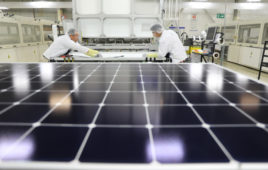A rural Arizona school near Navajo Nation gets a new solar and wind microgrid to power its growing demand.
Issues with getting power to areas out of utility reach in third-world countries are commonly discussed. But people don’t always realize many areas within the United States also face this problem. Off-grid solar has become a popular solution to provide power in these zones.

STAR School’s retrofit started in September 2013 and finished in August 2014.
This is the case for STAR School, a pre-K through 8th grade charter school located in a rural desert-area 25 miles outside of Flagstaff, Ariz. It is out of reach for connecting with utility lines, and installing them would be an expensive project. Yet, the site was the perfect location for the school because of its proximity to a Navajo reservation where many of its students live.
The Navajos and surrounding community value sustainable living and self-reliance. To solve its power needs, the school installed a solar system and seven wind turbines over 15 years. But three wind turbines were destroyed by cyclonic winds and the solar array wasn’t performing as planned. The school was forced to pay as much as $5,000 a month to run a 30-kW propane generator.
After receiving a Native American Preference Grant, the school decided to invest in its power system and turned to Mark Snyder Electric (MSE) and Elsa Johnson, director of IINA Solutions, for help. Snyder’s Southern California-based full-service electrical contracting and alternative energy business came out to examine the project. At first look, founder Mark Snyder was taken aback by how poorly the existing system was installed.
“This was one of the worst systems I’ve seen,” Snyder remembered. “I was shocked to find residential solar equipment where commercial should have been used. The system was cobbled together and wind turbines destroyed. Solar panels were too close to the roof and each other, and the batteries were on the verge of failing because of insufficient charging performance.”
After the atrocious assessment, Snyder formulated a retrofit plan with four key improvements. He planned to set up a microgrid with AC coupling, convert the system to high-voltage strings, recondition the existing batteries and convert the system from single phase power to a balanced three-phase system while keeping the remaining four turbines.
Making the school a microgrid
Creating a robust microgrid for STAR School meant integrating several sources of power. The coordination of all power sources is handled by SMA’s Sunny Island battery-based inverter, which can be programmed to operate in several different modes, in this case off-grid. The Sunny Island and Sunny Boy inverters can communicate with SMA’s monitoring system, which allows Snyder to manage the system remotely over the internet and make sure it’s performing properly, even though the site is hard to visit regularly. Students enjoy how the SMA system records how much CO2 the system has saved the planet.
Snyder also installed 245 Kyocera, Sharp and Schott solar panels on the ground and the roof. Many of the panels and Unirac, Prosolar and other racking systems used were donated.
Benefits of AC coupling
MSE used an AC coupling method to optimize output. Traditionally grid-tied inverters that are programmed for off-grid applications or microgrids must convert electricity into usable AC power. In AC coupling, loads and energy sources are directly connected to a conducting AC bus bar, so additional DC to AC conversion is not required, increasing system efficiency. AC coupling also reduces battery usage and strain because it converts DC to AC power directly, rather than sending electricity into a battery and drawing it out again. This approach minimizes high-current, low-voltage DC connections and reduces installation costs and complexity.
Snyder also converted the system to three-phase power to allow the use of higher-efficiency motors for air conditioning and submersible pumps, and to provide for the school’s rapidly growing power demands.
Converting to higher voltage
MSE replaced the school’s 80-V installation with a 600-V system. Because power consumed by wires increases with current, upgrading to a higher voltage reduces current and transmission losses while increasing the system’s efficiency. The extra voltage helps provide 25% to 50% more power on cloudy and extremely hot days, compared with the old system.

The project won a Governor’s Award For Excellence in 2001 for being the first off-grid charter school in the U.S
Bringing batteries back to life
Part of the microgrid system also involves battery backup, but first Snyder had to decide what to do with the existing batteries. “After poor test results I really wanted to replace them,” he said, “but it wasn’t in the budget.”
Snyder was forced to turn to plan B, which was working with engineers on an equalization protocol to bring the batteries back to life. This involved measuring specific gravity, charting the batteries cell by cell and then replacing water. The team charged and discharged batteries for two months on a high equalization level to burn off built-up sulfation. This rehabilitation and the AC coupling will help prolong existing battery life, but once more money is available, MSE plans to completely replace the batteries with Crown Battery models, which Snyder says have tested well in similar environments.
Power generated from the solar and wind system is either directly used during the day or stored in battery banks and drawn as needed, such as on days with little wind or sun. If there are consecutive days where the renewables can’t generate enough power and the battery backup power doesn’t fulfill the school’s power needs, Snyder installed a propane generator for emergency backup power.
Results of the retrofit
By retrofitting the school’s array, MSE was able to increase the system’s output by 70%, saving the school thousands in propane costs. Solar power is the primary source of energy during the day, while wind turbines generate power at night and during storms when the solar panels may not. The nearly 450 kW on average generated every day by the solar and wind systems runs all computers, lights, kitchen appliances and even the well and pump that bring water into the school.
“It’s a mini power plant,” said the school’s co-founder and director Dr. Mark Sorenson in a student-made documentary.
Snyder said MSE, working with Elsa Johnson’s non-profit IINA Solutions, trained local Native Americans to work on the project and other nearby installations. “We aren’t just creating green power,” Snyder said. “We’re creating green jobs.”
Snyder said this retrofit approach can work in many systems. “If your solar array was installed before 2005, expect a nearly 50% greater output when upgrading to a high-voltage microgrid at a fraction of the cost of additional solar panels.”
Sorenson expressed in the student documentary how the successful microgrid could work for any school.
“If we can set up our school to be powered on solar, and we aren’t rich and we don’t have a whole lot of resources, then I think other schools can too,” he said. SPW




I’d like to know more about how the batteries were equalized and what parameters determined the completion of the process.
Hi Chris, I have obtained an answer from Mark Snyder: Hi Chris, Thanks for the Question. We have programmed the Sunny Island Master and Slaves to equalize every 7 days using the Battery Manufacturers parameters. It took about 3 months to take them from dead 1150 sg to 1300 sg . They are currently holding at 1285 – 1300 sg. The batteries float every day.
Thanks for that!
-cr
Chris Rollins, PE
+254 712 359 164 Kenya
+250 789 001 477 Rwanda
vertical-engineering Skype
Do you know vendors who can provide ant-reflection glass for solar panel?